The Eisenhower and RICE frameworks help you prioritize tasks and projects by combining qualitative and quantitative methods. Eisenhower sorts tasks by urgency and importance, making quick, visual decisions for immediate needs. RICE scores projects based on Reach, Impact, Confidence, and Effort, offering a detailed, data-driven ranking. Using both together can give you a balanced approach—addressing urgent issues while strategically focusing on high-impact work. Explore further to see how to integrate these methods effectively.
Key Takeaways
- Eisenhower prioritizes tasks based on urgency and importance, enabling quick, qualitative decision-making.
- RICE scores projects quantitatively using Reach, Impact, Confidence, and Effort for strategic prioritization.
- Eisenhower is faster and visually intuitive, while RICE provides more detailed, data-driven project rankings.
- Combining both methods allows for immediate task triage and in-depth project evaluation.
- Eisenhower suits urgent, operational decisions; RICE is ideal for planning long-term, high-impact projects.
Understanding the Foundations of Eisenhower and RICE
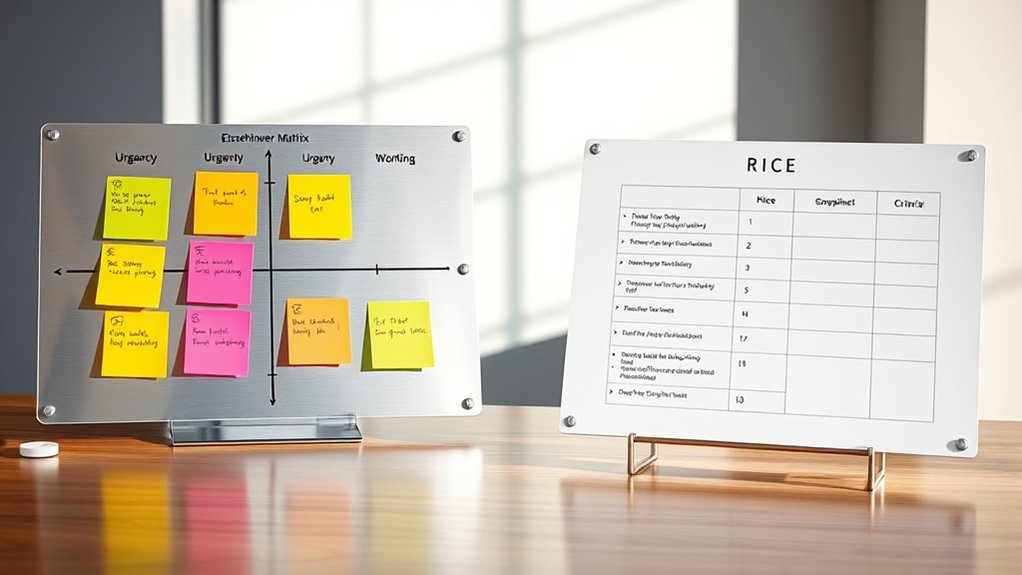
To understand the foundations of Eisenhower and RICE, it’s vital to recognize how each framework approaches prioritization. The Eisenhower method categorizes tasks into four quadrants based on importance and urgency, helping you quickly decide what needs immediate attention versus strategic action. It relies on qualitative judgment, emphasizing decision-making without detailed data. Additionally, understanding how project evaluation criteria influence decision-making can further clarify their differences. In contrast, the RICE framework scores projects using measurable criteria: Reach, Impact, Confidence, and Effort. This quantitative approach enables you to objectively compare initiatives through scoring, highlighting their potential value. Both frameworks serve to improve prioritization but differ in their importance and application. Eisenhower emphasizes time-sensitive, qualitative decision-making, while RICE focuses on data-driven, quantitative evaluation—each offering unique strengths for effective prioritization. Moreover, considering environmental considerations can help ensure that your project choices align with sustainable practices.
Comparing the Approach and Application of Both Frameworks
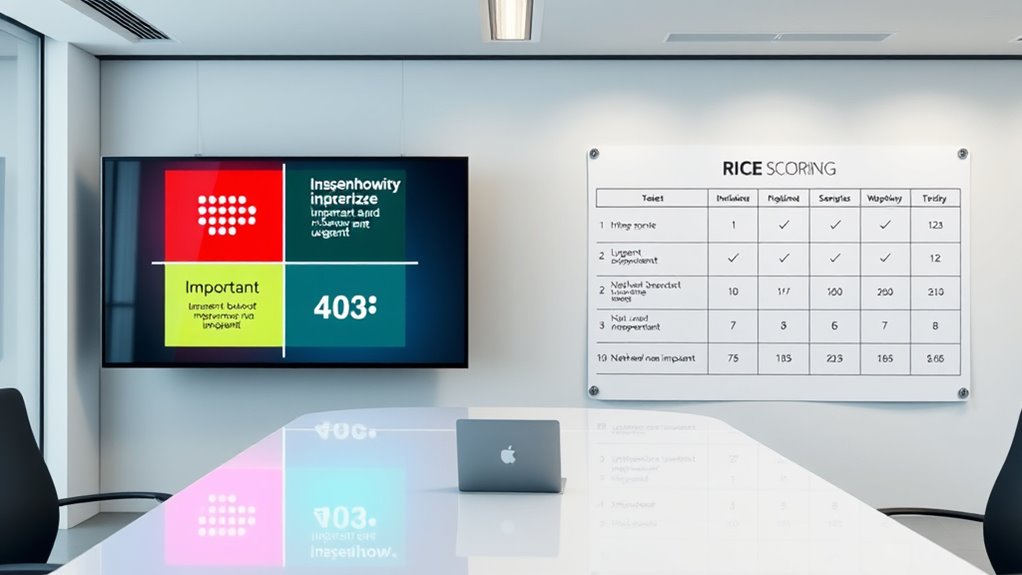
The ways in which Eisenhower and RICE frameworks are applied reflect their distinct approaches to prioritization. Eisenhower’s framework categorizes tasks by urgency and importance, enabling quick, qualitative decision-making ideal for task management and personal productivity. It emphasizes visual cues and immediate action, planning, or elimination. Additionally, Eisenhower’s method can be effective in managing tasks related to personal self-image and confidence, which are often influenced by cultural or astrological beliefs. Recognizing the task urgency and importance allows for effective time management and resource allocation, which can be crucial in high-pressure situations. Incorporating emotional impact considerations can further enhance decision-making processes within this framework. Furthermore, the use of vintage decor and rustic elements can inspire a more creative and relaxed approach to task prioritization, encouraging a balance between productivity and personal comfort. Conversely, RICE uses a scoring system—considering Reach, Impact, Confidence, and Effort—to assign numerical priorities, making it better suited for strategic planning and decision-making about projects. While RICE offers objectivity through quantification, it requires estimating metrics that can be subjective. Understanding the importance of payment data protection can help organizations implement effective security measures to prevent data breaches and fraud. Combining both allows you to categorize tasks by urgency and importance while ranking projects based on data-driven scores, facilitating balanced prioritization across different contexts.
Strengths and Limitations in Different Contexts
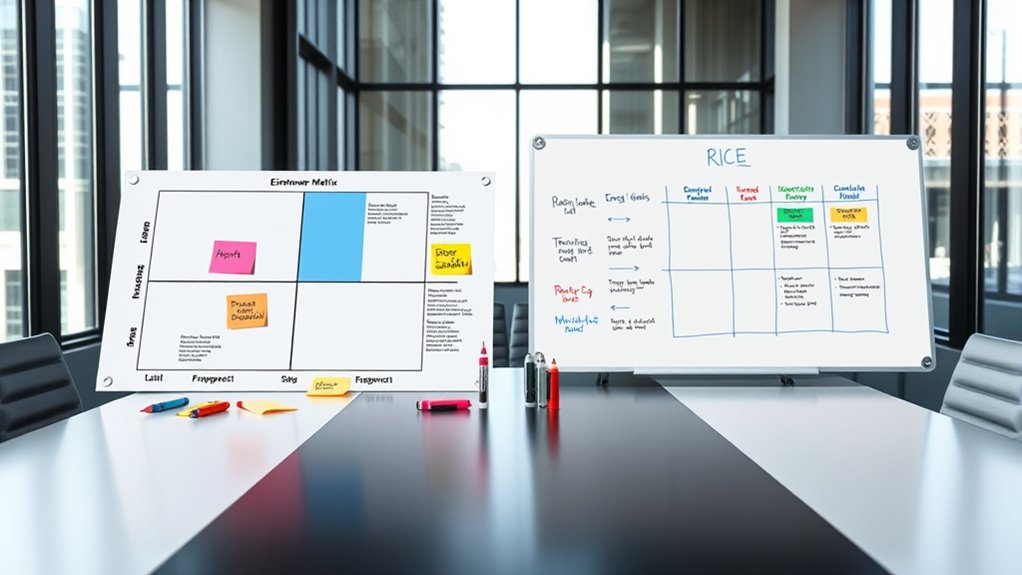
Evaluating the strengths and limitations of Eisenhower and RICE frameworks reveals how each suits different prioritization needs. The Eisenhower Matrix excels in quick decision-making based on urgency and importance, offering a visual, effort-focused approach ideal for immediate tasks. RICE provides a data-driven, quantitative method, perfect for strategic planning and resource allocation in complex projects. However, RICE can be time-consuming and depends on accurate estimates, while Eisenhower may overlook long-term impact. Use the table below to compare their strengths and limitations:
| Strengths | Limitations |
|---|---|
| Fast, visual sorting | Lacks data-driven rigor |
| Ideal for urgent tasks | Less effective for strategic prioritization |
| Supports quick decision-making | Can miss long-term impact |
Practical Scenarios for Choosing Between Eisenhower and RICE
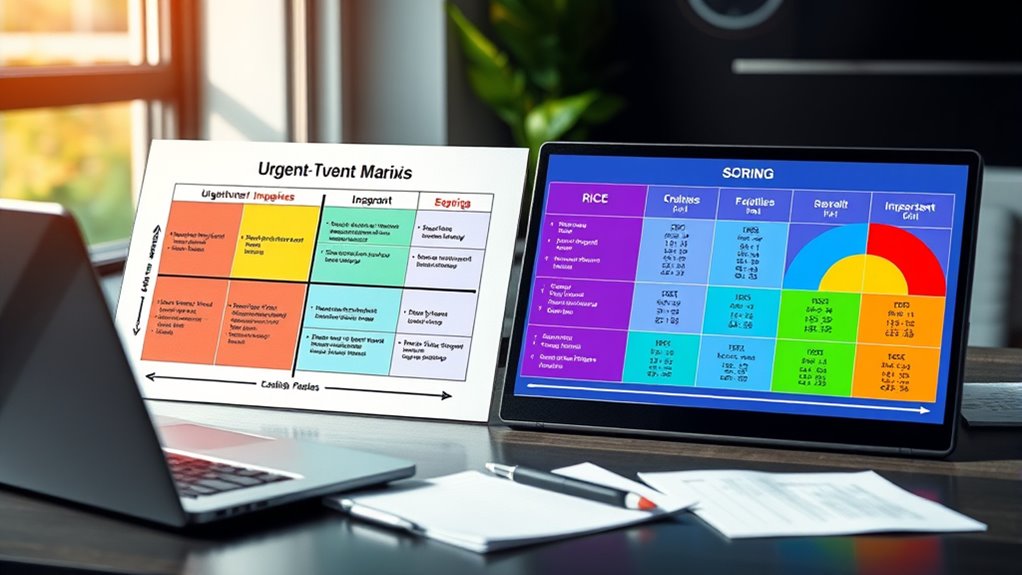
Choosing the right prioritization framework depends on the specific context and goals of your task management.
Use the Eisenhower matrix when handling urgent and important tasks, like critical outages or looming deadlines, to quickly allocate resources and maintain efficiency. It’s ideal for fast-paced environments where speed and simplicity matter most.
On the other hand, apply RICE when prioritizing strategic projects or features with measurable data on Reach, Impact, Confidence, and Effort. This data-driven approach helps refine prioritization, ensuring resources go toward initiatives with the highest potential impact.
For the most effective results, consider combining both methods: first sort tasks by urgency and importance, then use RICE to rank initiatives within each category. This blended approach balances immediate needs with strategic growth.
Integrating Both Methods for Balanced Decision-Making
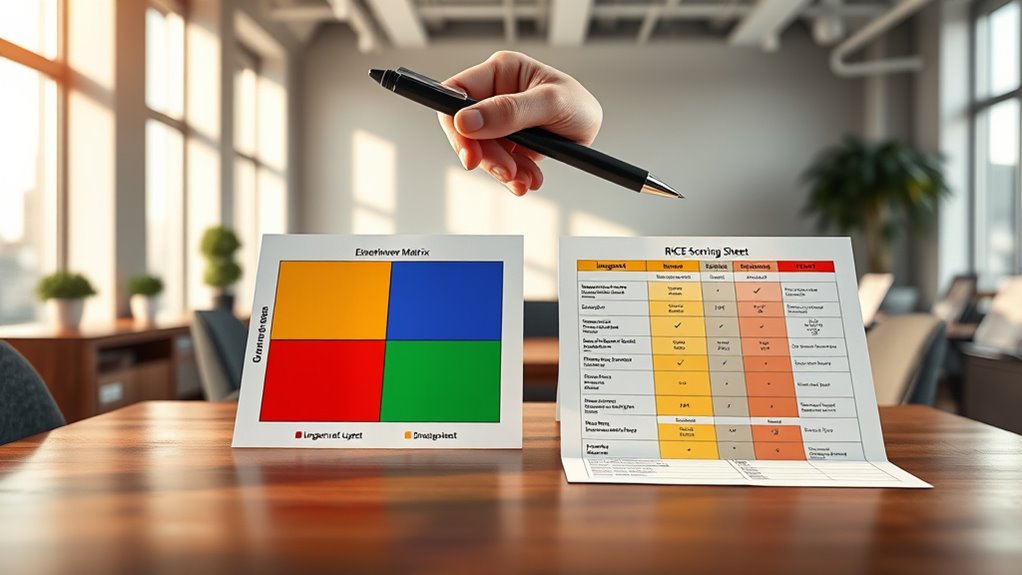
Integrating both the Eisenhower Matrix and RICE scoring enables your team to balance urgency with strategic impact effectively. First, use the Eisenhower Matrix to categorize tasks by urgency and importance, providing a clear visual overview. Then, apply RICE scoring within each quadrant to prioritize tasks based on impact, effort, and confidence. This integrated framework guarantees urgent tasks are addressed promptly while high-impact projects are systematically ranked for strategic planning. Combining these methods improves decision-making by balancing rapid response with objective evaluation, reducing bias, and supporting resource-efficient product development. Here’s how the task ranking process looks:
| Eisenhower Matrix Quadrant | RICE Scoring Priority |
|---|---|
| Urgent & Important | High RICE score |
| Not Urgent & Important | Moderate RICE score |
| Urgent & Not Important | Low RICE score |
| Not Urgent & Not Important | Minimal RICE score |
| Long-term Projects | High RICE impact |
Frequently Asked Questions
What Is the Best Prioritization Framework?
When you need to decide what to focus on first, choosing the best prioritization framework depends on your situation.
If you’re handling urgent tasks or crises, use a quick, strategic method like Eisenhower to sort tasks efficiently.
For long-term projects or features, RICE helps you make data-driven decisions.
Combining both approaches allows you to address immediate needs while aligning efforts with your overall goals.
What Is the Eisenhower Model of Prioritization?
Did you know that over 80% of tasks are often low value? The Eisenhower model helps you focus on what truly matters by dividing tasks into four quadrants based on urgency and importance.
It encourages you to prioritize urgent and important tasks first, delegate or eliminate less critical ones, and plan for long-term goals. This way, you manage your time effectively and stay aligned with your strategic objectives.
What Is the Difference Between Rice Framework and WSJF?
You want to understand how RICE and WSJF differ. RICE assigns scores based on Reach, Impact, Confidence, and Effort, helping you prioritize features or projects with data-driven insights.
WSJF, on the other hand, calculates priority by dividing the Cost of Delay by job duration, focusing on maximizing economic value.
If you want balanced scoring, RICE works; for maximizing ROI, WSJF is more effective.
What Is the Difference Between Rice and Moscow Prioritization?
When comparing RICE and MoSCoW prioritization, you see that RICE uses measurable scores—Reach, Impact, Confidence, and Effort—to rank features objectively.
MoSCoW, on the other hand, categorizes tasks into Must-have, Should-have, Could-have, and Won’t-have based on stakeholder importance.
RICE helps you make data-driven decisions, while MoSCoW focuses on stakeholder consensus and strategic importance without quantitative scoring.
Conclusion
Now that you’ve explored Eisenhower and RICE, think of them as two tools in your decision-making toolbox—each shiny and sharp in its own way. By understanding their strengths and quirks, you can craft a balanced approach, like a skilled chef blending flavors. Whether you’re prioritizing urgent tasks or evaluating potential impact, these frameworks help you steer your project ship through calm and stormy waters alike, making sure you reach your destination smoothly.









